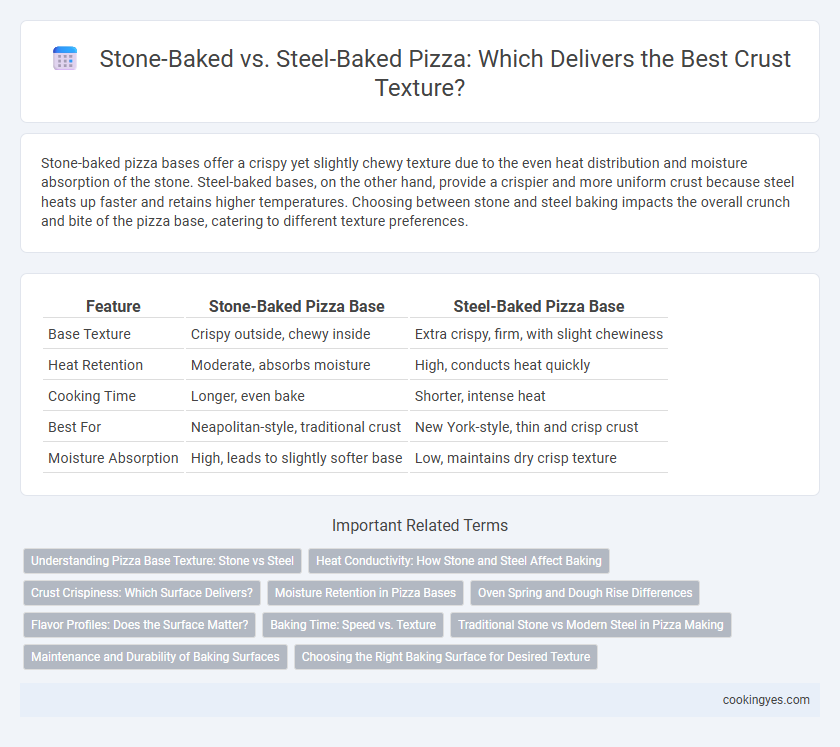Stone-baked pizza bases offer a crispy yet slightly chewy texture due to the even heat distribution and moisture absorption of the stone. Steel-baked bases, on the other hand, provide a crispier and more uniform crust because steel heats up faster and retains higher temperatures. Choosing between stone and steel baking impacts the overall crunch and bite of the pizza base, catering to different texture preferences.
Table of Comparison
| Feature | Stone-Baked Pizza Base | Steel-Baked Pizza Base |
|---|---|---|
| Base Texture | Crispy outside, chewy inside | Extra crispy, firm, with slight chewiness |
| Heat Retention | Moderate, absorbs moisture | High, conducts heat quickly |
| Cooking Time | Longer, even bake | Shorter, intense heat |
| Best For | Neapolitan-style, traditional crust | New York-style, thin and crisp crust |
| Moisture Absorption | High, leads to slightly softer base | Low, maintains dry crisp texture |
Understanding Pizza Base Texture: Stone vs Steel
Stone-baked pizza bases achieve a crisp, uneven texture due to the porous surface of the stone that absorbs moisture and radiates intense, radiant heat evenly. Steel-baked pizza bases benefit from rapid heat conduction, creating a uniformly crisp crust with a slightly chewier bite, ideal for thin-crust styles. The choice between stone and steel impacts the pizza base texture significantly, with stone promoting rustic crunch and steel enhancing a consistent crispness and chew.
Heat Conductivity: How Stone and Steel Affect Baking
Steel's superior heat conductivity enables faster and more even heat transfer, resulting in a crispier pizza base with well-defined charred spots. Stone surfaces absorb and retain heat more evenly but conduct heat slower, producing a chewy crust with a slightly softer texture. The choice between stone and steel significantly impacts the pizza's bottom texture, balancing crispness and chewiness based on heat distribution.
Crust Crispiness: Which Surface Delivers?
Stone-baked pizza crust is known for its ability to absorb moisture, resulting in a crispy yet slightly chewy texture that balances crunch with tenderness. Steel-baked pizza surfaces conduct heat more efficiently, producing an intensely crispy and evenly browned crust with a satisfying snap. For optimal crust crispiness, steel delivers faster baking times and a distinct crunch, while stone provides a traditional texture celebrated for its rustic chew.
Moisture Retention in Pizza Bases
Stone-baked pizza bases excel in moisture retention due to their porous surface that absorbs and redistributes heat evenly, preventing excessive drying. Steel-baked bases, while providing higher heat conductivity, tend to create a crisper crust but may lose moisture faster, resulting in a drier texture. The choice between stone and steel baking surfaces significantly influences the balance between crust crispness and moist, tender interior in pizza bases.
Oven Spring and Dough Rise Differences
Stone-baked pizza crusts typically achieve a crispier, more evenly cooked base due to the porous nature of the stone, which absorbs and radiates heat effectively, promoting a steady oven spring and moderate dough rise. Steel-baked bases benefit from the superior thermal conductivity of steel, resulting in rapid, intense heat transfer that creates a pronounced oven spring with a lighter, airier crumb and greater dough rise. The choice between stone and steel significantly influences crust texture, with steel producing a quicker rise and lighter finish, while stone yields a thicker, chewier base.
Flavor Profiles: Does the Surface Matter?
Stone-baked pizza crusts develop a slightly charred, smoky flavor due to the porous surface that absorbs moisture and allows for even heat distribution. Steel-baked crusts promote a crispier texture with a more pronounced caramelization of sugars, enhancing a slightly nutty and toasted flavor. The choice of surface significantly influences the base's flavor profile by altering heat conduction and moisture retention, shaping the overall taste experience.
Baking Time: Speed vs. Texture
Stone-baked pizzas typically require longer baking times, allowing the heat to distribute evenly and create a crisp, chewy crust with a rustic texture. Steel-baked pizzas cook much faster due to the high thermal conductivity of steel, producing a more intense heat that results in a thinner, crunchier base. The choice between stone and steel baking hinges on whether a slower, textured crust or a rapid, crisp finish is preferred.
Traditional Stone vs Modern Steel in Pizza Making
Traditional stone-baked pizza bases offer a crispy yet chewy texture due to the stone's ability to retain and evenly distribute heat, creating a rustic char and authentic flavor. Modern steel-baked bases benefit from steel's superior heat conductivity, producing a faster bake time and a uniquely crispier crust with a slight crunch. Both methods influence the pizza's final texture, with stone providing tradition-rich warmth and steel delivering innovatively sharp crispness.
Maintenance and Durability of Baking Surfaces
Stone-baked pizza bases offer a naturally porous surface that requires regular cleaning to prevent oil absorption and cracking, ensuring long-term durability. Steel-baked surfaces demand less maintenance due to their non-porous, rust-resistant qualities, providing consistent heat distribution without frequent seasoning. Choosing steel enhances durability with lower upkeep, while stone requires attentive care to maintain texture and longevity.
Choosing the Right Baking Surface for Desired Texture
Stone-baked pizza crust delivers a crispy, evenly cooked base with a slight chewiness due to its porous surface, which absorbs moisture and distributes heat gradually. Steel-baked surfaces provide a higher thermal conductivity, resulting in a thinner, crisper crust with quick and intense browning ideal for New York-style pizzas. Selecting between stone and steel depends on the desired crust texture--stone for a rustic, chewy bite and steel for a crisp, crackly finish.
Stone-baked vs Steel-baked for base texture Infographic

 cookingyes.com
cookingyes.com